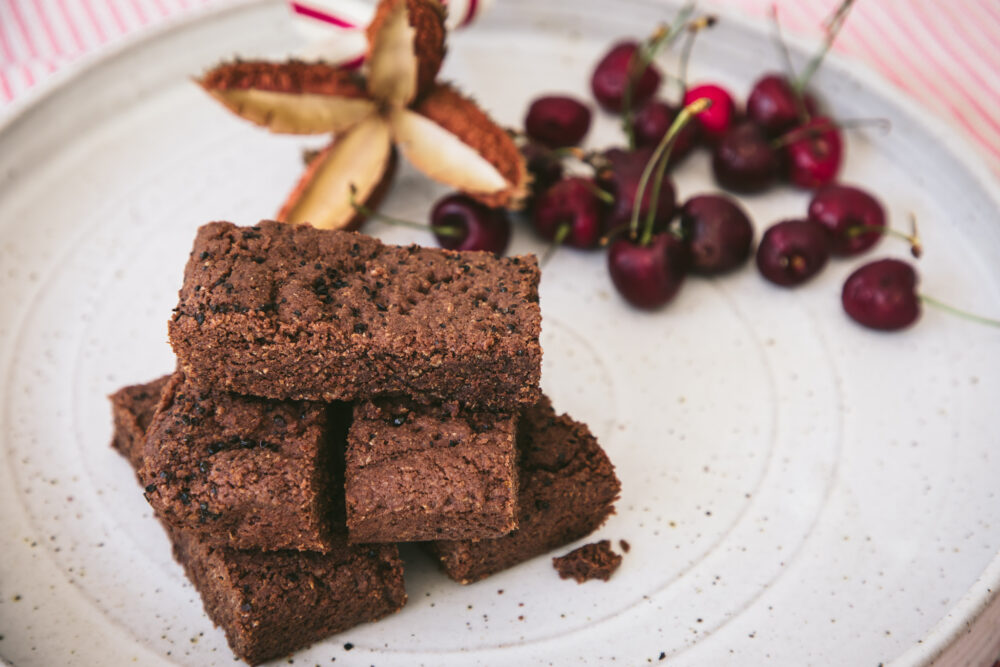Chocolate and wattleseed: a delicious combination
I made chocolate and wattleseed shortbread last weekend and it lasted for 24 hours. I kid you not. My kids don’t always love the treats I bake as I often tweak the ingredients, reducing the sugar and adding dried fruit, or perhaps rolled oats or shredded coconut.
For this particular recipe, I didn’t mess with the quantities of sugar and butter – this is no doubt why it tastes so good! However, I did deviate from the traditional shortbread recipe to use wholemeal flour and raw sugar.
This Christmas, I’m making chocolate and wattleseed shortbread to give to family and friends.
Wattleseed: an Indigenous staple food
Wattleseed, from the Acacia tree, has been a staple food for Indigenous Australians for thousands of years as a rich source of protein, fibre and carbohydrate. It has the flavour and aroma of roasted coffee, nuts, sweet spice and chocolate.
Traditionally used in Aboriginal cuisine, wattleseed was typically ground into flour for damper. More recently, it has been used in a number of sweet and savoury foods, such as icecream, muffins, roast meats, teas, and even as a substitute for coffee.
The gum, flowers, leaves and bark from various species of wattle were also used as bush medicine to treat diarrhoea, blisters and burns, coughs, eczema, as well as general sickness.
Where to buy wattleseed
Although there are about 985 different species of Acacia in Australia, there are only a small number of edible wattles; the others are poisonous. Therefore the gathering of wattleseed should only be conducted under expert guidance.
Wattleseed is sold roasted, either whole or ground.
Here are a few suppliers:
Why is it called shortbread?
The large amount of butter is what makes shortbread short: the term short, when applied to biscuits and pastry, means crumbly, like shortcrust pastry should be. The traditional ratio of one part sugar to two parts butter lends a high fat content to the dough. It is the reason why the fat added to biscuits and pastries is called shortening.
It can make the dough a little difficult to work with. Many recipes call for chilling the shortbread dough in the tin before scoring it and then cooking it, as with this chocolate and wattleseed shortbread, or rolling the dough into a log, chilling it and then cutting it into biscuits before cooking.

Shortbread in its original form
The original shortbread, dating back to the 12th century, was a type of ‘biscuit bread’ or twice baked biscuit. They were made from left-over bread dough, sometimes sweetened and dried out in the oven to form a hard, dry rusk.
This practice took place not just in Scotland, but all over the British Isles.
The shortbread in its original form would have been rather hard and not very sweet. But to people of the time, this labour-intensive baking which took a long time to make, using scarce resources, would have been seen as a rare and precious luxury.
The Queen’s Biscuit
For a few hundred years, shortbread was made in this way, slowly baking the dough in the oven until hardened and served as an occasional treat. Gradually, the leavening was replaced by butter, and by the time Mary, Queen of Scots came into power in the 16th century, the shortbread had developed to a sweeter, more crumbly and ‘short’ biscuit.
In this form, shortbread became an expensive fancy treat that was only bought for celebrations such as Christmas and Hogmanay (Scottish New Year). There are similar ‘breads’ outside of Scotland such as Shrewsbury cakes and Goosnargh cakes.
More shortbread recipes
I love adding herbs to shortbread recipes. You might like to try this brown sugar shortbread with walnuts and rosemary or this savoury parmesan and thyme shortbread.
Best wishes,
Amanda
PS: If you’ve tried this chocolate and wattleseed shortbread or any other recipe from At Amanda’s Table, please let me know how it turned out in the comments below. And, if you’d like to read more, please subscribe to my monthly newsletter for stories, recipes and tips for simple, nutritious meals.

Chocolate and Wattleseed Shortbread
Ingredients
- 300 g unsalted butter, softened
- 220 g raw sugar (1 cup)
- 375 g wholemeal flour (2 1/2 cups)
- 5 tbsp good quality cocoa powder
- 1/4 tsp bicarbonate of soda
- 1 tbsp roasted wattleseed
- 1/4 tsp salt
Instructions
- Grease and line a lamington tin (18 cm x 28 cm) with baking paper.
- Sift the flour, cocoa, soda and salt into a bowl and set aside.
- Beat the softened butter and sugar in an electric mixer until creamy in texture.
- Add the flour mixture gradually and beat slowly until just combined.
- Press into the prepared lamington tin, smooth out the top and refrigerate for 15 minutes. At this time, preheat the oven to 180℃ (160 ℃ fan-forced).
- Remove from the fridge, use a knife to score the chilled dough into 12 pieces. This makes it much easier to break apart once it's cooked.
- Prick the dough all over with a fork and sprinkle with the wattleseed. Cook the shortbread for 25 minutes until it's firm to touch.
- Allow the shortbread to cool slightly before turning it onto a wire rack. Cool completely before storing it in an airtight container.
- The shortbread will keep in an airtight container for up to a week.

Leave a Reply